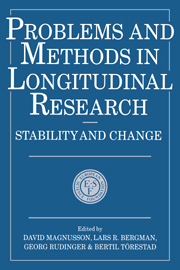Book contents
- Frontmatter
- Contents
- Contributors to this volume
- Foreword
- Preface
- 1 Studying individual development: problems and methods
- 2 Modeling individual and average human growth data from childhood to adulthood
- 3 Intraindividual variability in older adults' depression scores: some implications for developmental theory and longitudinal research
- 4 Now you see it, now you don't – some considerations on multiple regression
- 5 Differential development of health in a life-span perspective
- 6 Assessing change in a cohort-longitudinal study with hierarchical data
- 7 Statistical and conceptual models of ‘turning points’ in developmental processes
- 8 Qualitative analyses of individual differences in intra- individual change: examples from cognitive development
- 9 Application of correspondence analysis to a longitudinal study of cognitive development
- 10 Event-history models in social mobility research
- 11 Behavioral genetic concepts in longitudinal analyses
- 12 Genetic and environmental factors in a developmental perspective
- 13 Structural equation models for studying intellectual development
- 14 Longitudinal studies for discrete data based on latent structure models
- 15 Stability and change in patterns of extrinsic adjustment problems
- Index
13 - Structural equation models for studying intellectual development
Published online by Cambridge University Press: 27 April 2010
- Frontmatter
- Contents
- Contributors to this volume
- Foreword
- Preface
- 1 Studying individual development: problems and methods
- 2 Modeling individual and average human growth data from childhood to adulthood
- 3 Intraindividual variability in older adults' depression scores: some implications for developmental theory and longitudinal research
- 4 Now you see it, now you don't – some considerations on multiple regression
- 5 Differential development of health in a life-span perspective
- 6 Assessing change in a cohort-longitudinal study with hierarchical data
- 7 Statistical and conceptual models of ‘turning points’ in developmental processes
- 8 Qualitative analyses of individual differences in intra- individual change: examples from cognitive development
- 9 Application of correspondence analysis to a longitudinal study of cognitive development
- 10 Event-history models in social mobility research
- 11 Behavioral genetic concepts in longitudinal analyses
- 12 Genetic and environmental factors in a developmental perspective
- 13 Structural equation models for studying intellectual development
- 14 Longitudinal studies for discrete data based on latent structure models
- 15 Stability and change in patterns of extrinsic adjustment problems
- Index
Summary
INTRODUCTION
In this chapter we investigate in turn the following issues.
We test systematically hypotheses concerning the conceptual differentiation of reliability of intelligence measures and stability of intelligence constructs as a feature of the developmental process itself.
We test hypotheses about longitudinal changes in structure of the intelligence constructs over time indicated by sets of observables. This is of general interest in intelligence longitudinal research, particulary concerning the differentiation/reintegration hypothesis of intelligence.
We study both problems with intelligence data from the Bonn Longitudinal Study of Aging (BOLSA).
The Bonn Longitudinal Study of Aging (BOLSA) was started in 1965 with a sample of 222 women and men born in 1890-5/1900-5. The younger cohort (1900-5) consisted of 114 persons and the older one (1890-5) of 108. Of the 114 younger subjects, 55 were women and 59 men and in the older cohort there were 49 women and 59 men. Each measurement period took five days; during this period three semistructured interviews were administered, each of which focused on different sections of our subjects' lives. Furthermore, subjects underwent a series of intelligence tests (WAIS/HAWIE, Raven test), psychomotoric, and personality tests, and were examined by a specialist for internal medicine.
- Type
- Chapter
- Information
- Problems and Methods in Longitudinal ResearchStability and Change, pp. 274 - 307Publisher: Cambridge University PressPrint publication year: 1991
- 5
- Cited by



